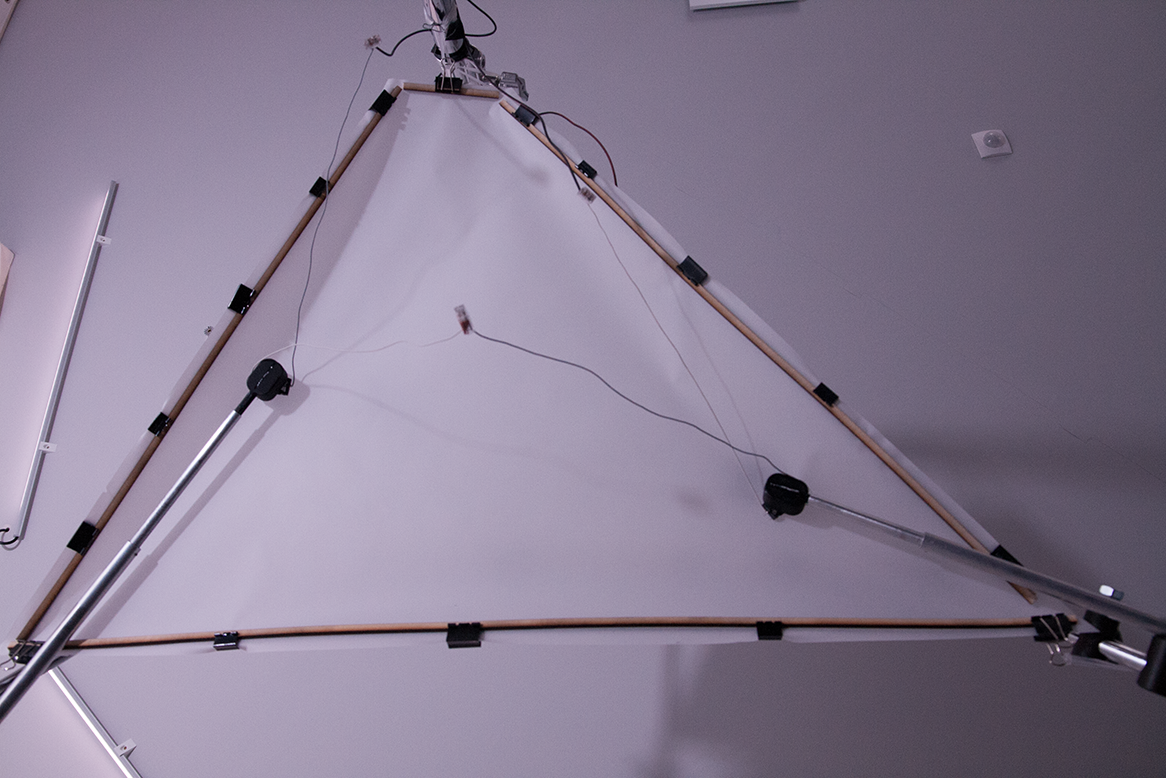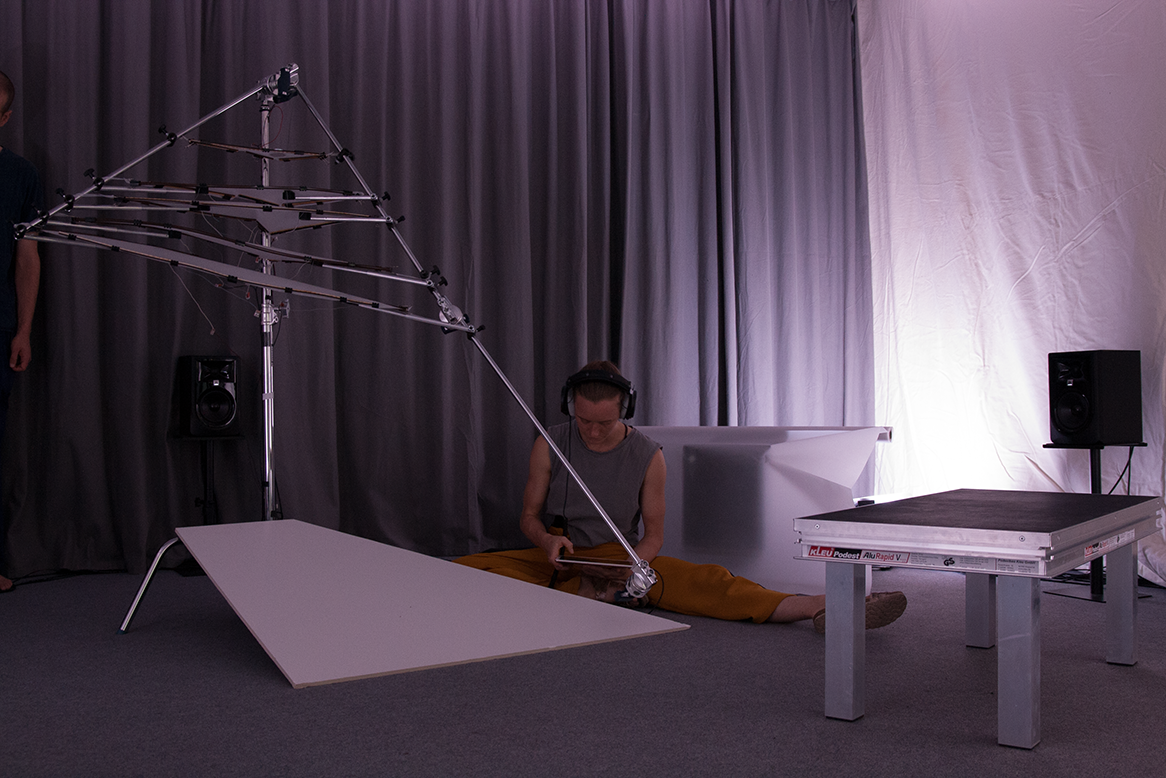Common Grounds
2020-
Common Grounds is an artistic-scientific research exploring strategies for sonifying environmental data. This research asks how a long-term collaboration between climate science and sonic arts can be translated into public experiences that communicate and offer embodied, sensorial connections to the fragile complexity of planetary systems.
Climatic changes occur on spatial and temporal scales much larger and slower than those we humans can sensorially perceive. Therefore even in the face of palpable damages to the earth's atmo-, hydro-, cryo- and geo-spheres, the climate crisis still remains for many but an inaccessible, looming threat. Drawing on detailed instrumental datasets starting 1998 from the fastest warming place on earth - the circumpolar region of the Arctic, the collective develops custom software, sonic and choreographic instruments, storytelling strategies and participatory somatic practices towards producing a constellation of artistic outputs including a sonic environment made of sounding sculptures and stories, a participatory performance in form of a concert-lecture, a music record, a video work and an art-science publication.
In Twenty Springs the Sono-Choreographic Collective installs a sonic environment drawing on their artistic-scientific research Common Grounds*. This installation uses a detailed set of hourly environmental data points recorded since 1998 at the Bayelva permafrost measurement station at the Svalbard archipelago in the high arctic region of Norway. Through the custom software developed by the collective in collaboration with Tobias Grewenig, the 33 parameters of the dataset are translated and fed into an array of multi-channel sounding sculptures. Compressed into a single hour, it sonifies the first twenty springs of the current millenium as a navigable, storied, sound-light environment.
This environment establishes an analogous, artificial ecology that maintains an underlying connection to the distribution of sensors installed at the Bayelva research site. The physical-spatial relations of its sound sources stand for the sensors at the arctic station. Spread in space three-dimensionally, they establish relations with the visitors' moving and listening bodies on both horizontal and vertical planes. In addition, a CO2 sensor measures the local atmosphere and includes the effect of the visitors’ breath, incorporating the installation space and the visitors into the sounding data stream.
Bringing together distributed and localized sound sources, electro-acoustic techniques are used, mainly of sound transduction onto layers of tensed paper membranes and foam boards. They are excited by self-developed instruments made of transducer units: bone-conductors, exciters and bass shakers and are joined by one active subwoofer, a ring of near-field audio-monitors and DMX controlled ambient lights.
Operating at different scales, other spatial and musical mappings are at play in Twenty Springs. The data stream of each sensor is modulating the wavetable positions and filters of a synthesized tone. The local CO2 sensor's data stream is the only one that modulates not a synthesized sound but recordings of freezing and melting processes taken in the geophysical lab of the permafrost research group. When all these voices are joined together, the installation sounds as a fluctuating chord whose tones are also mapped to the relative position of the sensors within the station: High pitched sounds are mapped to the changing conditions of the air, lower ones play the layered ground(s) and the bass sonifies the underground. In addition, this drone’s tuning is heard as a very slow rise: Climbing 192 cents during the sixty minutes loop, it is the sounding analogy to the measured 1.92°C mean temperature rise at the Bayelva site in the last 20 years.
Joining the sounds, in order to better navigate the spectrum of active agents and possible perspectives within this environment, other orientation mechanisms assist the visitors. A visual ‘time anchor’ aids the orientation by connecting the polar day-night rhythm, manifesting in the arctic as a one long ‘polar day’ and one long ‘polar night’ through every solar year, the ambient light intensities correspond to the sun’s position within the dataset. Finally, an interactive map of the space, connected to a narrative audio-guide is offered to the visitors. Sonifying climate data through storytelling and narration, this guide helps to establish a common ground for listening, using headphones in order to better personally connect on the move with the environmental soundscape. Taking the form of short stories told through the perspective of each of the station's sensors, they per-sonify these objects and provide the visitors with important factual and affective entry points into the experience.
Climatic changes occur on spatial and temporal scales much larger and slower than those we humans can sensorially perceive. Therefore even in the face of palpable damages to the earth's atmo-, hydro-, cryo- and geo-spheres, the climate crisis still remains for many but an inaccessible, looming threat. Drawing on detailed instrumental datasets starting 1998 from the fastest warming place on earth - the circumpolar region of the Arctic, the collective develops custom software, sonic and choreographic instruments, storytelling strategies and participatory somatic practices towards producing a constellation of artistic outputs including a sonic environment made of sounding sculptures and stories, a participatory performance in form of a concert-lecture, a music record, a video work and an art-science publication.
In Twenty Springs the Sono-Choreographic Collective installs a sonic environment drawing on their artistic-scientific research Common Grounds*. This installation uses a detailed set of hourly environmental data points recorded since 1998 at the Bayelva permafrost measurement station at the Svalbard archipelago in the high arctic region of Norway. Through the custom software developed by the collective in collaboration with Tobias Grewenig, the 33 parameters of the dataset are translated and fed into an array of multi-channel sounding sculptures. Compressed into a single hour, it sonifies the first twenty springs of the current millenium as a navigable, storied, sound-light environment.
This environment establishes an analogous, artificial ecology that maintains an underlying connection to the distribution of sensors installed at the Bayelva research site. The physical-spatial relations of its sound sources stand for the sensors at the arctic station. Spread in space three-dimensionally, they establish relations with the visitors' moving and listening bodies on both horizontal and vertical planes. In addition, a CO2 sensor measures the local atmosphere and includes the effect of the visitors’ breath, incorporating the installation space and the visitors into the sounding data stream.
Bringing together distributed and localized sound sources, electro-acoustic techniques are used, mainly of sound transduction onto layers of tensed paper membranes and foam boards. They are excited by self-developed instruments made of transducer units: bone-conductors, exciters and bass shakers and are joined by one active subwoofer, a ring of near-field audio-monitors and DMX controlled ambient lights.
Operating at different scales, other spatial and musical mappings are at play in Twenty Springs. The data stream of each sensor is modulating the wavetable positions and filters of a synthesized tone. The local CO2 sensor's data stream is the only one that modulates not a synthesized sound but recordings of freezing and melting processes taken in the geophysical lab of the permafrost research group. When all these voices are joined together, the installation sounds as a fluctuating chord whose tones are also mapped to the relative position of the sensors within the station: High pitched sounds are mapped to the changing conditions of the air, lower ones play the layered ground(s) and the bass sonifies the underground. In addition, this drone’s tuning is heard as a very slow rise: Climbing 192 cents during the sixty minutes loop, it is the sounding analogy to the measured 1.92°C mean temperature rise at the Bayelva site in the last 20 years.
Joining the sounds, in order to better navigate the spectrum of active agents and possible perspectives within this environment, other orientation mechanisms assist the visitors. A visual ‘time anchor’ aids the orientation by connecting the polar day-night rhythm, manifesting in the arctic as a one long ‘polar day’ and one long ‘polar night’ through every solar year, the ambient light intensities correspond to the sun’s position within the dataset. Finally, an interactive map of the space, connected to a narrative audio-guide is offered to the visitors. Sonifying climate data through storytelling and narration, this guide helps to establish a common ground for listening, using headphones in order to better personally connect on the move with the environmental soundscape. Taking the form of short stories told through the perspective of each of the station's sensors, they per-sonify these objects and provide the visitors with important factual and affective entry points into the experience.








20 Springs, installation view; Bayelva Station; Photo credits: Bnaya Halperin-Kaddari, Kerstin Ergenzinger; AWI Potsdam
Common Grounds is an artistic-scientific project and is being developed together with Kerstin Ergenzinger and the Sono-Choreographic Collective in collaboration with Tobias Grewenig and the Permafrost research group led by Julia Boike at Alfred-Wegener-Institut Potsdam.
Data sonification software and methods are developed in collaboration with Tobias Grewenig. The Audio Guide Voice is narrated by Atalya Tirosh and the audio-guide programming is by Moshe Levine.
Up to now this project has been supported by HIDA - Helmholtz Information & Data Science Academy, The Academy for Theater and Digitality, the Alfred-Wegener-Institut, Helmholtz Centre for Polar and Marine Research, the Malmö City Cultural Council and the Sound Environment Center at Lund University.
To read more about the process and thinking behind the work, visit our wiki page here